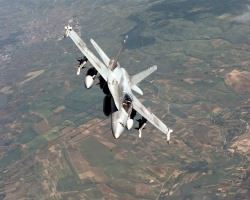|
The F/A-18E/F Super Hornet: A Test Pilot Dispels The Myths By CDR Rob Niewoehner |
||||
|
The F/A-18A/B/C/D’s phenomenal growth in systems and missions are at the brink of physically exhausting the space of a 1970s airframe, while the weapons system inside is unquestionably 1990s. Modest improvements from Lot XX C/D to E/F are all that is initially required to make the Super Hornet state-of-the-art. What is needed is a 1990s airframe that can handle the growth for the avionics and weapons systems advances of the next 5 to 20 years. The F/A-18E/F is that airframe. Where technological jumps in E/F avionics were possible, they were made. The touchscreen Up-Front Control Display (UPCD) is the most prominent feature of the Super Hornet cockpit. While other services were tentative about embracing touchscreen for tactical aircraft applications, we’ve seen this display move successfully to maturity. The prime piece of real estate dedicated to administrative tasks in the heritage Hornet (the UFC, or Up-Front Control), is now a full participant in the warfighting display suite. Flight Test Highlights How’s the airplane flying? Seven aircraft, in the third year of a flight test program at the Naval Air Weapons Centers at Patuxent River and China Lake, have flown more than 3,000 flight hours. Five Navy pilots share envelope expansion responsibilities with five Boeing/Northrop test pilots. Highlights of the testing to date have included Initial Sea Trials (January 1997, aboard USS Stennis), Operational Test Phase IIA (November 1997), and more than a million pounds of weapons expended off the aircraft. The weapons separation effort is key to the entire program. It represents the true product to be delivered to OPTEVFOR/VX-9 for the Operational Evaluation (OPEVAL) in the summer of 1999 – an airplane ready to go to war with several dozen cleared weapons loads. This represents a significant challenge to the test team. Hanging heavy, aerodynamically significant stores on a flexible structure means that each of the desired configurations is virtually a different airplane to be cleared for its flying qualities, performance, flutter, loads, and weapons separation. Due to the scope of the weapons program, it is not uncommon for the weapons-separation aircraft to be dropping bombs and firing missiles in parts of the envelope cleared only days prior by the airplanes devoted to airworthiness testing. Results of testing to date have generally been very encouraging. Performance is coming in right on predictions. Technical challenges surface daily. They are an expected part of a "test, analyze, fix" process, the highly publicized "wing drop" having been only one of scores Boeing and the Navy have faced together. Each of the seven aircraft are being modified continually to accommodate what has been learned in the previous weeks and months. The effort is strongly focused around preparedness for the airplane’s final exam (OPEVAL). |
 Flying Qualities But what is it like to fly? "It’s a Hornet, only better," were my comments after my first flight. When one accounts for the 90 percent commonality with the C/D avionics suite, nearly identical cockpit switch positions, and preflight procedures copied directly from the C/D NATOPS manual, a Hornet pilot’s first impression is to feel right at home. It’s upon second glance that the changes become more significant. An E-model’s start-up internal fuel state is 14.5 (14,500 pounds of fuel), vice the C’s 10.7 (10,700 pounds). The Up-Front Control has been replaced by the versatile touchscreen Up-Front Control Display. Up and away flight handling is very similar to the C/D’s by design, though less susceptible to the anomalies the C/D exhibits at some conditions. In the landing pattern, even the C/D’s wonderful handling characteristics have been improved upon, with the increased weights providing better rejection of low-altitude gusts and much more stable ground handling. The airplane doesn’t even appear to notice load asymmetries to 30,000 ft-lbs. Approach angle-of-attack remains the same, but the larger wing provides for substantially lower approach speeds. In summary, getting comfortable flying the airplane takes no time at all, but the changes are so positive that a pilot may not want to go back even to the C/D. Flash vs. Value "What does the F/A-18E/F have for me?" Appreciating the F/A-18E/F also includes understanding the benefits to all of Naval aviation’s stakeholders. The E/F does not include every flashy type of technology ever mentioned in Aviation Week, but rather those that deliver significant warfighting value. The F/A-18E/F does not universally out-perform all of the airplanes it is replacing. Any aircraft with the F/A-18’s multi-mission capability will necessarily compromise some attributes to maximize the best overall capability. While every pilot longs for "more knots and more turn rate," each needs to realize the value of the enhancements the F/A-18E/F brings to the carrier’s arsenal and to every interested warfighter in the joint arena. Go to Part IV
|
|||
|
Copyright © 1997 - 2000 COMBATSIM.COM, INC. All Rights Reserved. Last Updated January 6th, 1999 |
||||
